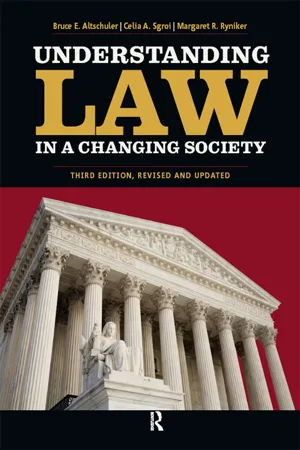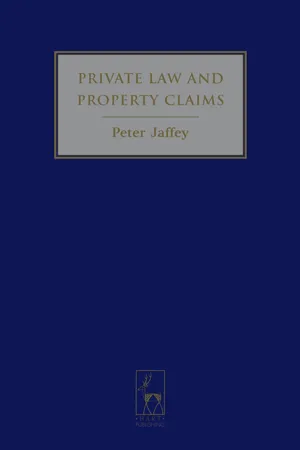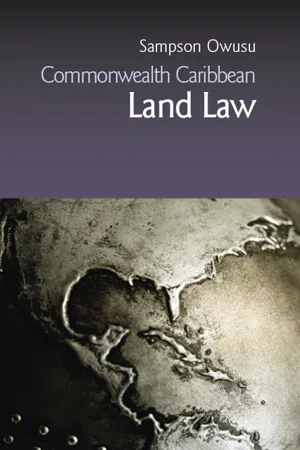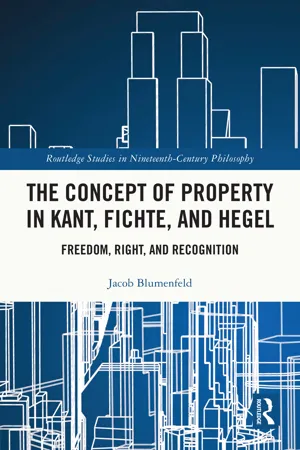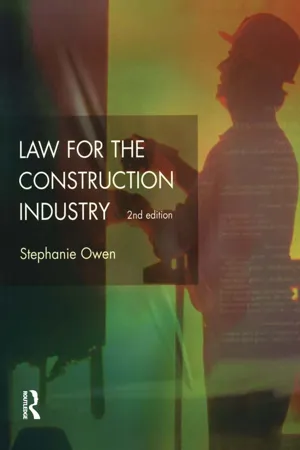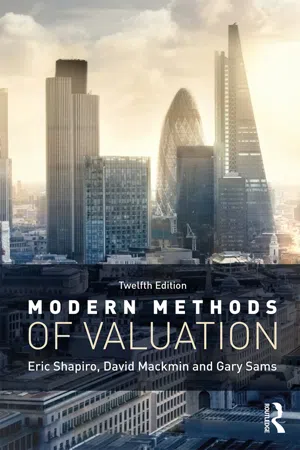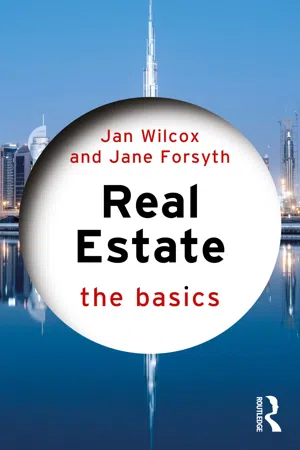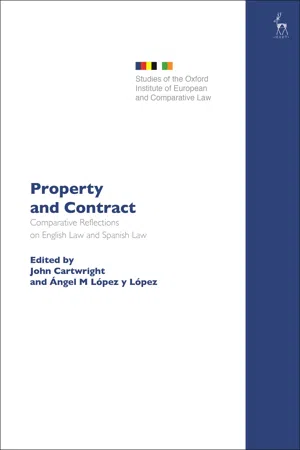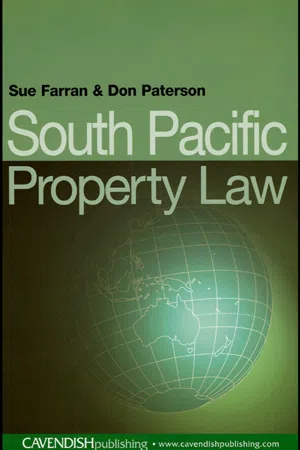Law
Property Law
Property law encompasses the rules and regulations governing the ownership, use, and transfer of real and personal property. It covers a wide range of legal issues, including property rights, landlord-tenant relationships, and property disputes. Property law aims to protect individuals' rights to possess, use, and dispose of their property while also balancing the interests of the community.
Written by Perlego with AI-assistance
Related key terms
12 Key excerpts on "Property Law"
- eBook - ePub
- Bruce E. Altschuler, Celia A. Sgroi, Margaret R. Ryniker(Authors)
- 2016(Publication Date)
- Routledge(Publisher)
HAPTER 6Property CHAPTER OBJECTIVES After reading this chapter you should be able to: • demonstrate a basic understanding of how property is defined and how it has evolved over time;• know the meaning of the terms real property, personal property, tangible property, intangible property, and fixture;• describe and explain the rights of ownership; and • discuss the concept of entitlements and their purpose. INTRODUCTIONProperty is the oldest of the substantive subjects in common law and one of the most important and respected. The right to own property, together with freedom of contract, builds the foundation for capitalist society and is specifically protected by the U.S. Constitution. It is not really an exaggeration when law school students are told that all law is about property—how to get it, how to keep it, and how to pass it on.This chapter examines what property is and what it means to own something. These are ideas that have changed somewhat over time, even though property, more than most legal subjects, appears to represent what we might call “well-settled law”—concepts and rules that were firmly established centuries ago and are remarkably resistant to change. Nevertheless, our ideas about property have both expanded and contracted over the years, and it is likely that William Blackstone, who surveyed the English law of property in the middle of the eighteenth century, or Oliver Wendell Holmes Jr., who commented on principles of Property Law in late-nineteenth-century America, would be surprised by some features of the modern law of property.Definitions of PropertyGenerally, when laypersons use the word “property,” they are referring to specific tangible objects and, most often, to land. Although land and material objects are frequently the subjects of property, property encompasses a great deal more than material things. In modern legal terms, property is not things at all but, rather, a collection of rights and entitlements people have in relation to things and, perhaps even more important, in relation to other people. The right of property includes the right to acquire, possess, use, enjoy, and dispose of that which is owned. This legal right predates the Constitution but is affirmed and guaranteed by it in the Fifth and Fourteenth Amendments, which state that the federal and state governments may not deprive a person of property without due process of law. - eBook - ePub
- Peter Jaffey(Author)
- 2023(Publication Date)
- Hart Publishing(Publisher)
3 Property and Property Claims PRIVATE PROPERTY AS A JUSTIFICATORY CATEGORY Private Property Property Law addresses the problem of how to allocate the benefit of ‘things’ or resources. This is a functional definition of Property Law in the sense referred to in chapter 1. 1 Traditionally the most important such things have been land and goods, and in ordinary usage Property Law most often refers to land law and the law of goods or chattels. For some people, strictly speaking property is confined to tangible things, and is used of intangible things, such as contractual rights or choses in action, or intellectual property, only in an extended or figurative sense. I will take the view that property can include intangible things, including money, as discussed below. The characteristic feature of a system of private property is the right of ownership, which is the exclusive right to all the benefit of a particular thing or ‘object of property’, encompassing the right to control it and determine how it is used or disposed of, and the right to benefit from it through use or exploitation by sale or licensing. 2 One can conceive of a private property system consisting only of rights of ownership, so that there are only discrete units of property each controlled by an owner who is entitled to all the benefit of it. 3 But in reality there are bound to be, in addition, ‘lesser property rights’, which confer an entitlement to some specific aspect of the benefit of an object of property belonging to someone else, in derogation of his right of ownership, so that the benefit of things is divided up in more complex ways. In the case of land, this is neces sitated by the interdependence of land use. In land law, an easement is a right to make some limited use of land owned by another person, eg for access; and a restrictive covenant gives a benefit to a neighbour in the form of a constraint on use by the owner - eBook - ePub
- Sampson Owusu(Author)
- 2021(Publication Date)
- Routledge-Cavendish(Publisher)
CHAPTER 1DEFINITION AND CLASSIFICATION OF PROPERTY
Property connotes many things and it is therefore difficult to define. “The law of property”, according to Lawson, “attempts to answer a number of questions about the relations of persons to things”.1“Property” is used to signify things which are the subject matter of ownership, e.g., tables, books, cars – these are classified as movable things, or personal property. Land, on the other hand, is called real property. Other “things” which are valuable, but which exist as concepts and not as objects capable of being reduced to physical possession, such as corporate stocks, bonds, patents and copyrights, are referred to as intangible personal property or choses in action.A contract involves a relationship between persons respecting a thing, but its principal role lies in the enforcement of promises. Many other relations between persons affecting things do not have anything to do with promises. Contract primarily gives rise to a relationship which is in personam, i.e., a relation between two persons; only the parties to the contract can sue and be sued on it. All other persons are not affected and are, therefore, excluded.Property, on the other hand, denotes a right in rem. This means that it gives rise to rights which are enforceable not only against the parties to the transaction, but against the whole world.The distinction between contractual and property rights becomes blurred when a contract creates a right which can be transferred or assigned. Such a right becomes an asset, which can be expressed in terms of monetary value and is therefore protected against invasion by all other persons.Invasion of one’s person is protected by law against the whole world, just as any right in rem - eBook - ePub
- David Cowan, Lorna Fox O'Mahony, Neil Cobb(Authors)
- 2023(Publication Date)
- Hart Publishing(Publisher)
8 Public Law, Human Rights and Property LawINTRODUCTIONIn previous editions of this book, we have sought to convey the excitement generated by the gradually unfolding story in the courts of the reception of human rights law into our understandings of Property Law. As we suggested, ‘These are amazing times to be a land lawyer’. They are still amazing times to be a land lawyer, but this particular field has now become relatively well-settled, other than for an occasional semi-dramatic moment.On its face, human rights and Property Law appear diametrically in conflict – on the one hand, there is the qualified right to respect for an occupier’s home, which is contained in Article 8, Schedule 2, Human Rights Act 1998; on the other hand, there is the basic principle of Property Law that owners (and at least some licensees) have better title to the land than an occupier without an interest in the property (whether or not the occupier regards the property as their home).1 As Ward LJ more elegiacally put this conflict:The idea that an Englishman’s home is his castle is firmly embedded in English folklore and it finds its counterpart in the common law of the realm which provides a remedy to enable the owner of the castle to secure the eviction of trespassers from it. But what if the invaders occupy for long enough to establish their home within the keep? Whose castle is it now? Whose home must the law now protect?2However, this conflict has now rather effectively been resolved by minimising the threat posed by those invaders.Previous chapters in this book have briefly mentioned human rights – in relation to the mortgagee’s right to possession, the doctrine of overreaching, and the landlord’s right to possession of occupied property. This chapter faces the issue head on. Although this chapter could range widely, its focus is on two elements: mandatory rights to possession (Debate 1 ); and peaceful enjoyment of possessions (Debate 2 - eBook - ePub
What About Law?
Studying Law at University
- Catherine Barnard, Janet O'Sullivan, G J Virgo(Authors)
- 2021(Publication Date)
- Hart Publishing(Publisher)
News of the World). If you want sex, lies, violence and vitality—the full gamut of human strengths and frailties—it is all here. Moreover, there is something for everyone: something for the theorist, the technician, the pragmatist, the romantic and the cynic alike. The reason is not hard to search out. The law of property is not ultimately about land or things. It is about ourselves; it is about the way in which we perceive our relationship with the external world; it is about the rapaciousness with which we choose to seize the resources and opportunities offered by that world. Here is an arena in which the agony and ecstasy of life are played out against a backdrop of abstract proprietary concepts.THE PROBLEM OF PROPERTYFor the student, the challenge of property is deeply internal. Property Law is, effectively, a kind of applied psychology. The law of property poses fundamental questions to which the answers lie not outside, but inside, oneself. How, in fact, do we think property? How absolute or sacrosanct should property entitlements be? How much room is there for notions of fairness in the allocation of property rights? What is the proper balance between justice, certainty and efficiency? Is Property Law simply about excluding other people from resources which one values or is it more about a sharing of socially valued resources with others? How do human rights and property rights interact? On what grounds can one’s property be taken away or confiscated? What is property anyway? The answers to such questions depend upon the private, latent, barely conscious assumptions and perceptions which each of us brings to the study of property. Yet our responses to these ancient questions have implications which go far beyond the immediate resolution of property disputes. Our conclusions impinge upon a whole range of modern debates—about personal privacy, civil liberty, distributive justice, social exclusion and environmental welfare—debates which are central to the way in which we live our lives. Property questions are profound; their reach is universal; their power to engage is immense. Small wonder that even Blackstone, in one of his more cheerful moments, recognised that there is ‘nothing which so generally strikes the imagination, and engages the affections of mankind, as the right of property’ (Blackstone Commentaries - eBook - ePub
The Concept of Property in Kant, Fichte, and Hegel
Freedom, Right, and Recognition
- Jacob Blumenfeld(Author)
- 2023(Publication Date)
- Routledge(Publisher)
economic function, not a political one. The sovereign right to exclude has been replaced by a bundle of rights that bind.At first, this model for understanding property was motivated by progressive jurists and legal realists who sought to break the stranglehold of absolute property rights tied to single owners.30 Instead, they conceived of property as a bundle of in personam rights of contract and exchange, all of which allows for more possibilities of redistribution, regulation, taxes, welfare, and entitlements. As the century progressed, the disintegration of property accelerated under razor sharp economic analyses of law. The motivations shifted across the political spectrum as libertarians and neoliberals developed complex economic theories of property rights without property—that is, rights to credit, finance, liabilities, contact, use, and exchange—all adequate to modern capitalist social relations in which people do not own things but titles, debts, shares, and ideas. Property Law, in this context, becomes a tool of coding value, not managing but creating wealth.31 Redistribution, taxes, and takings became the enemies of modern property theory, not because they contradict some vague idea of liberty but primarily because they do not increase the wealth of society, the only acceptable universal value left.32The meaning of property in the 20th century thus transitioned from a thing-based model of full ownership as the right to exclude to a person-based model of contractual ownership as a bundle of rights. Metaphysical tales and normative justifications lost their relevance as the necessity of property was universally proven by anthropological studies, historical reports, and economic data.33 Like epistemology in the 20th century, property became naturalized, and the only task left for scholars was to update it with the latest descriptive, behavioral, and economic science available. This is not, however, the end of the story. Contemporary legal scholars have recently challenged this consensus from all sorts of angles, such as by retrieving property as an in rem right to exclusive use for new reasons,34 reinserting social obligation and normative pluralism,35 reformulating the demands of distributive justice,36 revitalizing legal formalism,37 and returning to progressive accounts of property.38 - eBook - ePub
- J.R. Lewis, Stephanie Owen(Authors)
- 2014(Publication Date)
- Routledge(Publisher)
4Law of propertyIntroductionWhat does property mean?
What sort of property do you own? Make a list. The word property comes from the French word ‘propre’, meaning one's own, and thus property in law is anything capable of ownership.Your list should therefore include ‘things’ such as motor cars, clothes, jewellery, furniture, household goods, animals, food, cheques, copyright, patents, money and debts, as well as your house and land. You cannot own people or corporations.You will notice that out of this list some property is tangible, i.e. it can be touched or is physical. Other types of property are intangible and cannot be touched, such as copyright, patents, shares in a company, or goodwill.Possession and ownership
Property can be possessed or owned. What is the legal difference?Possession
This was recognised much earlier in history, as it is relatively easy to determine who is the possessor of something. It is a question of fact and needs no law to determine it. Because of the ease of proving possession, it is often said that ‘possession is nine tenths of the law’. Indeed, the person in possession of property has a better right to it than anyone else, except for the true owner. Thus, a squatter has rights, but only possessory rights, and they can never be better than those of the owner. If he remains on the land long enough, however, he may acquire ownership of the land by adverse possession. Similarly, if a person finds a lost ring he may have it returned to him by the police, but, if the true owner seeks its return within the limitation period, then the finder may be sued for the ring itself or its value. ‘Finders, keepers’ is only partly true.Ownership
This concept encompasses all the legal rights that can attach to property, so that the owner can do with the property whatever he wishes, including giving up possession. Ownership is therefore better than mere possession as the owner is entitled to possession as well, and can claim any property back that has been wrongly taken out of his possession. - eBook - ePub
- Eric Shapiro, David Mackmin, Gary Sams(Authors)
- 2019(Publication Date)
- Estates Gazette(Publisher)
3 Property Law 1. Land lawThe word “property” means the right that a person has in land or goods. So, in valuing land, the valuer is estimating the value of the rights (the property) that a person has in that land. Obviously a valuer has to understand the scope of these rights in order to carry out a competent valuation. If, for example, the valuer is valuing a freehold, it is necessary to understand what legal rights are embodied in that freehold as well as any legal restrictions on those rights. Such rights and restrictions are the subject of land law. Land in this context includes buildings and parts of buildings – section 205(1)(ix), Law of Property Act 1925.Land law principles are derived from the common law – the law evolved by the judges in thousands of cases over the centuries. This law was modernised, codified and simplified by the reforming legislation of 1925. This consisted of seven Acts of Parliament on various aspects of land law and includes the Law of Property Act 1925 which, as amended, sets out the basic rules governing the ownership, creation and transfer of estates and interests in land.2. Property rights in generalThe two principal rights or interests in land in England and Wales with which the valuer is concerned are known, respectively, as the freehold and leasehold. (The position in Scotland changed with The Long Leases (Scotland) Act 2012 which converted qualifying (residential) long leases into outright ownership with all such leases ceasing to exist after 28 November 2015.) Tenants of these qualifying leases became owners with responsibility for shared maintenance of common parts and shared liability for other matters. So in Scotland the valuer is primarily concerned with freeholds which may be owner-occupied or subject to short-term leases. Continuing concern in England and Wales in relation to the practice of selling long leases in residential property, often with onerous lease terms, has stirred political interest and changes are being made as set out in section 14 below. - eBook - ePub
Real Estate
The Basics
- Jan Wilcox, Jane Forsyth(Authors)
- 2022(Publication Date)
- Routledge(Publisher)
In this chapter, we will look at some legal basics, that provide a framework for areas of study and for practice, to develop your knowledge and understanding of real estate as a profession. Landlord and tenant law and some specific property rights are addressed in more detail in separate chapters.A useful starting point is to consider the law itself. What do we mean by the law and what do we mean when we talk about something being legal? There are three types of law that real estate practitioners need to be aware of:- Common law;
- Equity;
- Legislation.
COMMON LAW
In England and Wales common law is the law that has evolved over centuries, based on the decisions of the courts. These decisions may set legal precedents, which means that they create rules and principles that become law. Criminal courts are beyond the scope of this book, although there are crimes concerning real estate, for example in relation to health and safety, and money laundering. For our purposes it is the civil courts that we are concerned with when studying land law. When we use the terms ‘legal’ and ‘in law’ we are referring to the common law.Courts are organised in a hierarchy that enables appeals to be made to a higher court if the judge’s decision is not accepted by a party to a dispute. The general rule is that the lower courts, for example the County Court, must follow the decisions made by the courts further up in the hierarchy – the High Court, the Court of Appeal, and the Supreme Court. Each is required to follow the decisions of the courts above it. Historically, the House of Lords was the highest court, but the creation of the Supreme Court in 2009 heralded a clearer separation of Parliament and the judiciary.EQUITY
Equity originated in the Courts of Chancery and has also evolved over centuries. The role of equity is to alleviate the harshness that can characterise the common law. Equity is therefore founded on values of fairness and justice and it can be recognised by its maxims, or principles. Examples of these equitable maxims are: ‘equity regards as done, that which ought to be done’, and ‘he who comes to equity comes with clean hands’. Equity will therefore have regard to the conduct of the parties when considering what is fair and just. We will see some examples of equity in practice when we look at aspects of land law in more detail later on. - eBook - ePub
Property and Contract
Comparative Reflections on English Law and Spanish Law
- John Cartwright, Ángel M López y López, John Cartwright, Ángel M López y López(Authors)
- 2022(Publication Date)
- Hart Publishing(Publisher)
6 The Creation and Transfer of Property Rights by Contract in English Law JOHN CARTWRIGHTI. Introduction. Contract and Property: Independence and InterdependenceWe learn early in our legal training that contract and property are fundamentally different categories within the structure of private law. Contracts belong within the law of obligations, and create rights which, in principle, are personal to those involved in the creation of the obligations (the parties to the contract). Property is an entirely separate category of right which, in principle, is not limited to those involved in its creation but is able not only to be transferred for the benefit of third parties but also to burden third parties. The core distinction, expressed by Roman law, is between rights in personam and rights in rem,1 and the categoric separation of contract and property is also recognised in English law.2 The distinction in nature between contract and property leads our legal systems also to develop different procedures by which such rights can be created (and, where so permitted, transferred). For example, the requirements for the formation of a contract are different from the requirements for the creation or transfer of property rights, and in many situations requirements within the law of property are stricter than within the law of contract – such as in the formalities required for the creation or transfer of rights to certain forms of property.Each of the chapters in this book explores some aspect of the nature of contractual rights and/or property rights, in one jurisdiction or comparatively between jurisdictions. In this chapter, I want to consider one particular aspect of the relationship between contract and property: the way in which property rights can be created or transferred by contract. The focus here is English law rather than comparisons with the civil law because, as we shall see, English law has developed some solutions which are peculiar to the common law’s way of thinking. The chapter will also focus, at least in the first instance, on property rights in land, and contracts relating to land, since it is in this context that a particular link between contract and property has been developed, although later we shall see some general points that can be made about contracts to transfer property generally (including therefore contracts for goods as well as for land). In essence, the common theme of the chapter is when (and why) English law sees the contract to transfer a right of property as in itself having the effect of transferring the property right (or, at least, creating a - eBook - ePub
Protest, Property and the Commons
Performances of Law and Resistance
- Lucy Finchett-Maddock(Author)
- 2016(Publication Date)
- Routledge(Publisher)
proprietorial right of resistance is removed, the remainder of land law makes no sense – squatters’ rights are the state of exception upon which both individual and collective rights rely as they are based on an empirical possessory linking with the land.If we are to be speaking of land, then property as realty is the logical legal frame work. This is in terms of registration as state-recorded categories of ownership held in arboreal chains of deeds; or since the onset of the Land Registration Acts and reforms in England and Wales (Land Registration Acts 1925, 1936, 2002, Law of Property Act 1925, the Trustee Act 1925, the Settled Land Act 1925 and the Land Charges Act 1925), the grid-like Torrens database that allows for a jigsaw effect of entitlements (Pottage, 1998). The way in which the predominant culture of individual property rights has shaped and moulded the relationship with the land has been discussed by jurist Carl Schmitt (1950), where to think of law itself is to start with the land. What we lack in terms of our understanding of property (and this is true to the extent that this debate is replicated through the onset of the Land Registration Act 2002 and the shift from possession to registration), is the performed nature and contingency of property is not wholly described within legal rhetoric; from the clod of earth we are now removed to the grid of the database. Abstract rights in paper form do struggle to demonstrate the complex enactments that allow a property to ‘happen’ in legal ‘reality’. This differentiation between the material and abstract world is discussed in the work of Bottomley and Lim (2009), a return to the land itself and its reliance on an essence of law, that of time and space. - eBook - ePub
- Sue Farran, Donald Paterson(Authors)
- 2013(Publication Date)
- Routledge-Cavendish(Publisher)
For example, movable property may be pledged as security for a loan, whereby the pledgee (the person to whom the goods are pledged) takes possession of the goods. The pledgor parts with possession until the goods are redeemed by repayment of the moneys lent, but remains owner. During the pledge both the pledgor and the pledgee have interests in the property. 75 It is also possible for a series of rights to exist in respect of the same property. For example, a person may have a life interest in property which will, on the interest-holder’s death, pass to others. This may happen where under a will a deceased person leaves the family home to ‘his wife for her life and then to their children to be held in equal shares’. The children have an interest at the date of the grant, but it is suspended in effect until the wife dies. The law provides a number of legal frameworks for the temporal division of rights, which will now be considered. 1.4.1 Lease A lease is a concept derived from the common law introduced into the South Pacific region. It is based on the law of contract but relates to property. The parties to the contract of lease are the lessor and the lessee, sometimes referred to as the landlord and tenant, in the case of residential leases of land. The contractual agreement transfers certain property rights from the lessor to the lessee, usually for a certain period of time and often for payment. Thus it is possible to enter into a contract of lease regarding a motor vehicle, or to enter a contract of lease regarding a house, or land. Under the lease the lessee will acquire the use and possession of the property and will also incur certain obligations, such as keeping the property in good repair. The lessee will also have certain rights as regards the property both against the lessor and third parties
Index pages curate the most relevant extracts from our library of academic textbooks. They’ve been created using an in-house natural language model (NLM), each adding context and meaning to key research topics.
